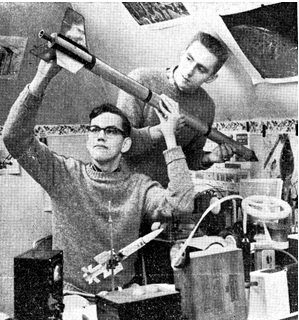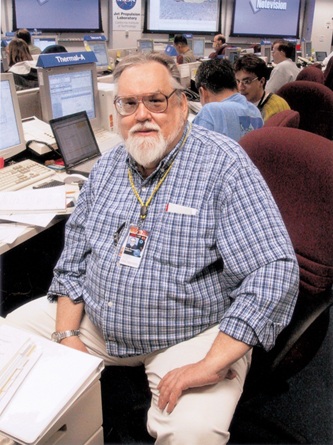 Thomas J. Wdowiak, Associate Professor Emeritus at the University
of Alabama at Birmingham (UAB), USA, and a member of the Mössbauer
Instrument team for NASA’s Mars Exploration Rovers (MERs), passed away
on 27 April, 2013. He was 73 years old.
Thomas J. Wdowiak, Associate Professor Emeritus at the University
of Alabama at Birmingham (UAB), USA, and a member of the Mössbauer
Instrument team for NASA’s Mars Exploration Rovers (MERs), passed away
on 27 April, 2013. He was 73 years old.
Planetary science and exploration were Tom’s lifelong passions.
Already at the tender age of 7, Tom’s interest in things
extraterrestrial was kindled by his discovery of a painting in the
basement library of his elementary school in Binghamton, New York, which
depicted Charles Bonestell’s idea of a Martian landscape. As Tom puts
it, “That’s the first time I was exposed to the concept of Mars as a
world – not a planet. There’s a difference. A planet, you look at. But a
world is a real place that you can stand on, can walk around on!”
Shortly thereafter he was following his passion for science by
carrying out chemistry experiments in the basement of his family’s home.
In high school, he experimented with rockets. It was dangerous business,
but that didn’t deter Tom. At age 17, following the launch of Sputnik,
his expertise was suddenly in demand, and he was conducting lectures to
area science teachers on rocketry and satellites and being interviewed
by the local TV station about space travel.
Tom attended colleges in New York and Florida, completing his Ph.
D. degree in Astronomy and Astrophysics at Case Western Reserve
University in 1971. After 4 years at NASA Marshall Space Flight Center
in Huntsville, Alabama, he accepted a faculty position at UAB, where he
has been since that time. At UAB his research focused on understanding
the organic dust of interstellar space and its transformation into solar
system materials and on extraterrestrial material in general from the
perspective of exobiology.
 His involvement with Mössbauer spectroscopy began in the early
1980s while seeking an explanation for the polarization of starlight. He
had cleverly acquired a sample of the primitive meteorite Orgueil and
wanted to look for tiny magnetic grains, presumably of interstellar
origin, within it. Tom asked one of us (DGA) for an introduction to the
technique, and together we showed that superparamagnetic material was
indeed present in this meteorite. Later joint investigations of
exobiological interest included the discovery of nanophase ferric iron
at the 65-million-year-old KT boundary and the demonstration that
Mössbauer spectroscopy can identify all the iron-bearing minerals found
in samples of an iron-rich hydrothermal spring mound in Yellowstone
National Park.
His involvement with Mössbauer spectroscopy began in the early
1980s while seeking an explanation for the polarization of starlight. He
had cleverly acquired a sample of the primitive meteorite Orgueil and
wanted to look for tiny magnetic grains, presumably of interstellar
origin, within it. Tom asked one of us (DGA) for an introduction to the
technique, and together we showed that superparamagnetic material was
indeed present in this meteorite. Later joint investigations of
exobiological interest included the discovery of nanophase ferric iron
at the 65-million-year-old KT boundary and the demonstration that
Mössbauer spectroscopy can identify all the iron-bearing minerals found
in samples of an iron-rich hydrothermal spring mound in Yellowstone
National Park.
Tom was a dedicated educator, introducing an estimated ten
thousand students to astronomy during his teaching career at UAB. He was
very generous with his time in educating the public and was often seen,
heard, or read on local TV, radio, and newspapers. He described his
regular science column in the local newspaper, which he had for several
years, as follows: “each month I become ‘Tommy Test Tubes’ in the
Saturday edition of the Birmingham News/Post Herald, presenting a
full-page, in color, kids’ section of science experiments, all based on,
and tested by, my childhood experiences. The experiments utilize things
found in the home, at the supermarket, home improvements store, and of
course Radio Shack.” ‘Tommy Test Tubes’ is a nickname he had acquired as
a kid.
Among the many graduate students Tom mentored over the years,
Luther W. Beegle stands out as a sort of follower in Tom’s “footsteps.”
Since graduating with his Ph. D., he has spent 16 years at the Jet
Propulsion Laboratory as a research scientist and is currently a surface
sampling systems scientist for Curiosity, NASA’s successor to the MERs.
He writes about his time under Tom’s tutelage: “When I chose to attend
UAB, I did so after talking with Prof. Wdowiak about my potential
research interests. The breadth and depth of his research interests
allowed me to explore many different areas, all focusing on the goal of
exploring the universe and understanding conditions leading to the
origin of life. The word Astrobiologist was not in vogue until after I
left UAB, but when it started to enter the lexicon in the 2000s, I knew
it described Tom to a Tee. He was ahead of the curve on many things,
including convening a workshop, the Point Clear Exobiology
Instrumentation Workshop held in May 1996, to better understand the
difficulties in identifying life on another planet. This workshop was
planned before the famous paper on ALH84001 was published and before
most people realized what a difficult task it was to even define
extraterrestrial life, let alone identify it. He will be missed”
Tom was an avid reader of science and science fiction, and his
fertile imagination and ability to synthesize his acquired knowledge led
to several NASA-funded projects to investigate instrumentation for use
on other worlds, for example, Europa and Mars. A miniature laser-Raman
spectrometer he had conceived and developed (with DGA) was employed in
the 1999 NASA-APEX rover field trials, making measurements of Mojave
Desert rocks from the breakfast table of a recreational vehicle (RV). In
1997 Tom became an original Co-Investigator for the Athena instrument
suite, which includes a Mössbauer spectrometer and occupies each of the
two Mars Exploration Rovers.
Many of Tom’s MER colleagues have expressed their sorrow at
losing him and have offered insight into his character. Steve Squyres,
Athena Principal Investigator writes, “Tom had a great passion and
enthusiasm for space exploration in general and for Mars and our rovers
in particular. He will be greatly missed.” Göstar Klingelhöfer, MER
Mössbauer Instrument lead writes, “It was always a great experience to
discuss with Tom about space exploration, new ideas, and in particular
Mars. We will miss him very much.” Jim Rice writes, “As a boy growing up
in Alabama I remember seeing Tom numerous times on a local TV morning
show talking about NASA and educating the public on news in Space
Science.” There were many others…
Tom is survived by his wife Patricia, their two daughters,
Celeste and Suzanne (wife of PAG), two granddaughters and one grandson.
David G. Agresti, Professor of Physics Emeritus, University of
Alabama at Birmingham
Perry A. Gerakines, Astrochemist, NASA Goddard Space Flight
Center